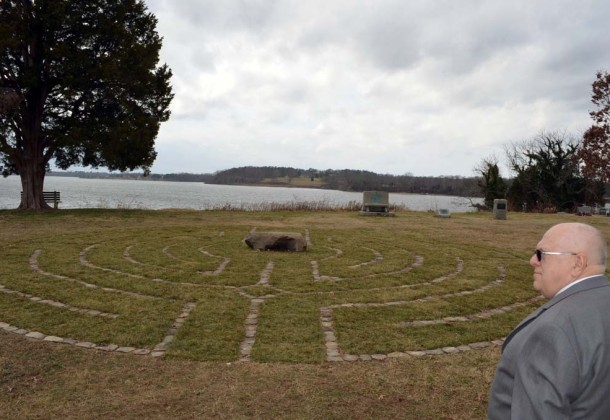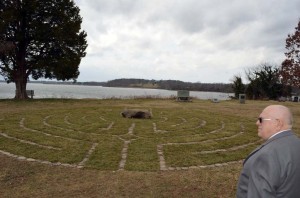Trinity Church Reshapes St. Mary’s City Landscape

Posted for Trinity Episcopal Church
Community Builder
By Jay Friess, editor

Father John Ball, rector at Trinity Episcopal Church, contemplates the chapel’s new meditation labyrinth.
Church Point and the Historic Triangle of St. Mary’s City is a place steeped in history, as is its sole living chapel, Trinity Episcopal Church. Residents take great pride in the area’s natural beauty and tranquil atmosphere.
So, when you make changes to the landscape in this town, you do so with great care.
In a flurry of activity perhaps not seen on the site since the 1930s, Trinity Episcopal Church has embarked on a transformational landscaping project, adding the “Angelic Gardens,” a memorial garden with columbarium in front of the church; a meditation labyrinth; and an event patio with columbarium. The church is also planning to build a second memorial garden with columbarium, called “Sunset Gardens,” between the college’s St. Mary’s Hall and the cemetery.
The effort was designed and overseen by the church’s rector, Father John Ball, whose passion for gardening and landscape design is second only to his calling as a priest.
On a recent tour of the construction site surrounding the church, Father Ball explained his theology of the church grounds serving as a “ministry of place,” where people can experience the presence of God and find spiritual peace by absorbing the natural and ambiance of the Historic Triangle of St. Mary’s City, the St. Mary’s River and Church Point.
“It’s utilizing the space to give people the opportunity to experience God’s deep and abiding presence,” Father Ball said of the project. “It’s a total experience.”
There is a pragmatic driving force behind this construction effort – Trinity is running out of places to bury people. The church’s existing columbarium, a collection of square, bronze covered niches for storing cremation remains, has only two spaces left. The church is also running out of graveyard space, as tombs have pushed to the boundaries of Church Point.
Father Ball said that the aim of the new columbarium is to provide space, not only for church members, but also staff, faculty and students of St. Mary’s College of Maryland and Historic St. Mary’s City who want to be buried close to the campus. The church’s sanctuary, rectory and hall properties run right down the middle of the college campus.
However, rather than create a square, imposing edifice on the church’s grounds, Father Ball said he began looking for a design that would entice the living to come see an appreciate its’ beauty.
“I had been thinking, ‘How can we do this in a beautiful way?'” Father Ball said, adding that he wanted a design that “sits gently on the land.” The church’s project occupies what Father Ball calls a “historically sensitive place.” With the college’s mid-century buildings and Historic St. Mary’s City sitting next door, it was important to ensure that the features would blend into and enhance the landscape, rather than impose on it.
He was thinking about how to accomplish this when he and his wife, Linda, attended the Washington Home and Garden Show in Washington, D.C. in May 2012. There, he met Jeff Reynolds, owner of Custom StoneScaping, a design build company located in Falls Church, Virginia, who was intrigued by the idea of transforming his garden designs into an inviting memorial.
Father Ball worked with Mr. Reynolds and Ned Brinsfield of the Brinsfield-Echols Funeral Home in Leonardtown, Maryland, to design a columbarium that would accommodate standard urns and serve as a flowing, natural-looking bench. The church received their construction permit just before Christmas.
So far, the columbarium is nearly complete, and the labyrinth is finished. Work has begun on the circular patio area, which will be ringed by a second columbarium. A third “sunset garden” area with more columbarium space is planned for the church’s northern graveyard; however, because it will be situated in what the planning and zoning people call “the extended buffer of the critical area,” the project is delayed until the church completes the process for obtaining a variance permitting them to move forward with the construction.
Much of the beauty of the Angelic Gardens is currently dormant for the winter, but Father Ball is eagerly anticipating when the garden’s trees and flowers come to life.
“It’s a work of art,” Father Ball said of the project. “It’s elegant.”
He said his congregation’s decision to transform their flat, open churchyard into a meditative space is seemingly affirmed on a daily basis. Since its completion, he has seen an increasing number of visitors exploring the church yard and several of them walking the labyrinth every day.
“It’s a spiritual experience,” he said.
- Father John Ball, rector at Trinity Episcopal Church, contemplates the chapel’s new meditation labyrinth.
- Meditation labyrinth
- Meditation labyrinth
- Angelic Gardens
- Angelic Gardens




























